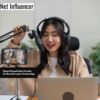-
Commentary
Digital Deception: How Trolls And Bots Shape Public Opinion
March 17, 2025A comprehensive literature review published in the European Scientific Journal reveals how trolls and bots manipulate...
-
Brand
BBC Studios Eyes YouTube And Digital Content Expansion With Success Of ‘Bluey’
March 17, 2025BBC Studios is scaling up its digital content strategy for hit preschool series “Bluey,” after the...
-
Commentary
Report Reveals Next Frontier For Brand-Creator Partnerships
March 17, 2025A new report from EMARKETER highlights the growing opportunity for brands in YouTube’s short-form video space. ...
-
Agency
The ‘Golden Nugget’ Hunters: How MODA PR Mines Creator-Brand Chemistry
March 14, 2025Ashley Rudd & Jennifer Delgado When Sophie Hughes, a body confidence expert, partnered with UK fashion...
-
Technology
Whalar Adopts Kantar’s LINK AI To Enhance Creator Marketing Effectiveness
March 14, 2025Whalar, part of Whalar Group and independent creator and social agency, announced a new partnership with...
-
Commentary
Lunar X: Building The ‘21st Century Disney’ For The Creator Economy
March 14, 2025Economics Explained—YouTube’s largest economics channel—recently premiered a feature-length documentary on CuriosityStream featuring interviews with former White...
-
Platform
How TikTok Transforms Brief Encounters Into Lasting Impressions
March 14, 2025New research from MAGNA reveals TikTok has become the primary platform for viewing and engaging with...
-
Platform
TikTok-Commissioned Study Shows Platform Supports 4.7 Million Jobs In U.S. Businesses
March 14, 2025A new study commissioned by TikTok has revealed that 4.7 million jobs in the United States...
-
Platform
Snapchat Platinum Unveils Advanced AI-Powered Video Filters
March 14, 2025Snap is rolling out exclusive AI video Lenses for subscribers of its premium Snapchat Platinum tier,...
-
Talent Collectives
Creator Management Firm Fixated Raises $10M In Funding Round Led By Eldridge Industries
March 14, 2025Fixated, a content creator management company founded in 2023, has secured a $10 million investment from...
-
Strategy
Elevating Influence From Tactic To Strategy: How Anorak Travel Creates Travel Campaigns With Purpose
March 14, 2025The Vogue Hotel Montreal faced a marketing emergency in 2021: new ownership had failed to acquire...
-
Commentary
Mom 2.0 Summit: Where Connections Create Career-Defining Opportunities
March 13, 2025Disney executives offering jobs. Netflix representatives scouting talent. Book deals signed over coffee. Mom 2.0 Summit...
-
Commentary
Spotter Showcase: Invite-Only Event To Connect Top Creators With CMOs And Agency Leaders
March 13, 2025Spotter is launching its first-ever Spotter Showcase, an invite-only event connecting CMOs and agency leaders with...
-
Technology
AI Startup OpusClip Secures $20M From SoftBank Vision Fund 2, Launches AI Video Search Tool
March 13, 2025OpusClip, a generative AI video editing startup, has secured $20 million in funding led by SoftBank’s...
-
Technology
Bridging Global Creator Divides: How Dreaminfluence And Irvine Partners Are Connecting Creator Economies
March 13, 2025A Nigerian nano-influencer earns stable U.S. dollars through a Danish technology platform, while a South African...
-
Technology
Beyond The Byline: Narcity Media’s Strategy For Empowering Local Creators In A Post-Publisher World
March 13, 2025Local media dies while independent creators thrive – Chuck Lapointe believes this scenario will become a...
-
Brand
Best Buy To Rollout Digital Storefronts For Content Creators, Influencers
March 12, 2025Best Buy plans to launch a program this spring enabling influencers and content creators to build...
-
Technology
Out2Win Lands $1.3 Million In Seed Funding To Advance AI-Enhanced Athlete Marketing
March 12, 2025Athlete marketing intelligence platform Out2Win has secured $1.3 million in seed funding to expand its AI-powered...
-
Platform
Ontario Schools Win Key Motion In Tech Company Lawsuits
March 12, 2025Ontario school boards have overcome a significant legal hurdle in their lawsuit against major social media...
-
Platform
Trump Reveals Four Groups Are Involved In Potential TikTok Deal
March 12, 2025U.S. President Donald Trump says that negotiations are underway with “four different groups” interested in acquiring...
-
Influencer
Influencer Soccer Charity Event Sells Out Wembley, Generates £4.7M, 17M+ Views
March 11, 2025The Sidemen Charity Match at Wembley Stadium on Saturday, March 8, raised £4,733,004 (~$6.1 million) for...
-
Technology
AvatarOS Raises $7 Million Seed Capital To Develop AI Influencer Technology
March 11, 2025AvatarOS has closed a $7 million seed funding round led by M13 with participation from Andreessen...
-
Platform
South Korea’s Educational Content Creators Get Boost From New YouTube Initiative
March 11, 2025YouTube is launching an “Education Expert Creator Support Program” in South Korea, partnering with the Teachers...
-
Commentary
AiMCO’s Sold-Out Influencer Events Signal The Return To In-Person Connection, Beauty’s Digital Renaissance
March 11, 2025The Australian Influencer Marketing Council’s (AiMCO) recent beauty influencer breakfast sessions exposed the creator economy’s hunger...
-
Brand
The Marathon, Not The Sprint: Matador Network’s Podcast Reveals The True Timeline of Creator Success
March 11, 2025Matador Network, a travel media company founded in 2006 with just $11,000, has survived where digital...
Connect with us




















































